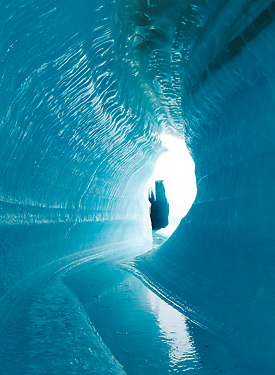Melting glaciers and ice caps on Canadian Arctic islands play a much greater role in sea level rise than scientists previously thought, according to a new study led by a U-M researcher.
The 550,000-square-mile Canadian Arctic Archipelago contains some 30,000 islands. Between 2004-09, the region lost the equivalent of three-quarters of the water in Lake Erie, the study found. Warmer-than-usual temperatures in those years caused a rapid increase in the melting of glacier ice and snow, says Alex Gardner, a research fellow in the Department of Atmospheric, Oceanic and Space Sciences who led the project. The study is published online in Nature on April 20.

This ice cave, or englacial melt channel, was formed by meltwater flowing within the ice of Belcher Glacier on Devon Island in Nunavut, Canada. It was photographed in August 2009. Photo by Angus Duncan.
“This is a region that we previously didn’t think was contributing much to sea level rise,” Gardner says. “Now we realize that outside of Antarctica and Greenland, it was the largest contributor for the years 2007 through 2009. This area is highly sensitive and if temperatures continue to increase, we will see much more melting.”
Ninety-nine percent of all the world’s land ice is trapped in the massive ice sheets of Antarctica and Greenland. Despite their size, they currently only account for about half of the land-ice being lost to oceans. This is partly because they are cold enough that ice only melts at their edges.
The other half of the ice melt adding to sea-level rise comes from smaller mountain glaciers and ice caps such as those in the Canadian Arctic, Alaska and Patagonia. This study underscores the importance of these many smaller, often overlooked regions, Gardner says.
During the first three years of this study, from 2004-06, the region lost an average of 7 cubic miles of water per year. That increased dramatically to 22 cubic miles of water — roughly 24 trillion gallons — per year during the latter part of the study. Over the entire six years, this added a total of 1 millimeter to the height of the world’s oceans. While that might not sound like much, Gardner says that small amounts can make big differences.
In this study, a one-degree increase in average air temperature resulted in 15 cubic miles of additional melting.
Because the study took place over just six years, however, the results don’t signify a trend.
The United Nations projects that the oceans will rise by a full meter by the end of century. This could have ramifications for tens of millions of people who live in coastal cities and low-lying areas across the globe. Future tsunamis and storm surges, for example, would more easily overtop ocean barriers.
The paper is called “Sharply Increased Mass Loss from Glaciers and Ice Caps in the Canadian Arctic Archipelago.”

